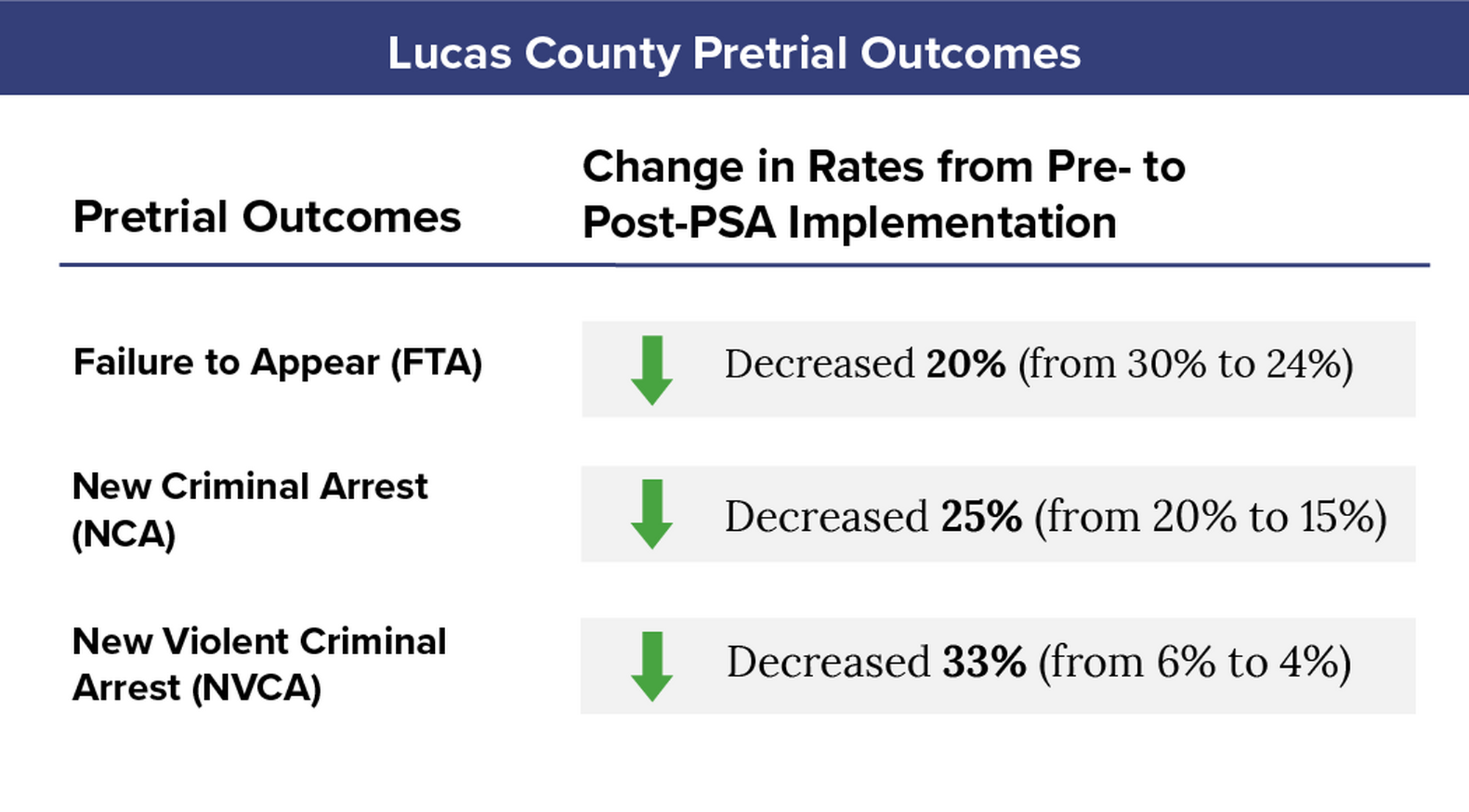Like many jurisdictions across the country, Lucas County, Ohio, has been rethinking its approach to pretrial decision making over the past few years. In 2015, it launched an ambitious effort to overhaul its pretrial system, which ultimately included improvements to nearly every phase of the pretrial process. These efforts have paid significant dividends: decreased bookings, lower jail population, and improved pretrial outcomes, including increased court appearances and fewer arrests.
Examining their System
Before 2015, Lucas County’s pretrial system mirrored many in the U.S.: There was a heavy reliance on financial conditions of release, which were based almost exclusively on someone’s charge. Judges had little standardized information when making pretrial release decisions. There were limited options for pretrial supervision tailored to people’s needs.
Lucas County also faced the challenge of complying with a federal consent decree—in place since the 1970s—aimed at addressing crowding in the jail. This decree not only established a firm cap on the number of people who could be held in jail but also set forth strict criteria for making emergency releases when that cap was reached—which was often the case.
Lucas County officials found the system’s pretrial outcomes unacceptable. Not only was jail crowding a persistent problem, but people were failing to appear for court and being arrested while on pretrial release at rates deemed unacceptable to county officials. By 2013, these concerns led some to call for the construction of a new jail to provide additional space for detaining people pretrial.
County officials decided that, before building a costly new jail, they should better understand who was in the existing jail, and why. They commissioned a jail population study, which was completed in 2014. They concluded that they needed a renewed focus on resource management and on ensuring that they were detaining the “right” people. Because of that study, Lucas County officials decided to undertake, as a first step, an ambitious plan to improve their pretrial system and the outcomes it produced.
An Ambitious Overhaul
Lucas County understood that improving its system would not be a simple matter of modifying one policy or adopting a particular tool. Instead, the county took a comprehensive approach to pretrial reform. Beginning in 2015 and continuing through the present day, Lucas County has made improvements to:
- Policing: Law enforcement has placed more emphasis on police–community relations and on finding alternatives to arrest. These measures included a greater focus on community policing, crisis intervention training for all officers, and more frequent diversion to drug and mental health treatment.
- Jail Bookings: Lucas County implemented the Public Safety Assessment (PSA) and uses the results to help identify people suitable for release prior to their first appearance. Pretrial services officers are authorized by the court to release people at booking, based on agreed-upon criteria. For instance, pretrial services can release people charged with nonviolent misdemeanors who receive low scores on the PSA.
- First Appearances: PSA results are also used to help inform judicial decisions at first appearance hearings.
- Early Case Resolution: The public defender’s office leads a program to identify cases, based in part on PSA results, that can be resolved at arraignment through dismissal or plea. Early resolution reduces the need for future court appearances (thus driving down missed court dates) and expedites the release of people who otherwise might spend days or weeks in jail.
- Differential Supervision: PSA results are used to help assign people to different levels of supervision—low, medium, and high— based on their likelihood of returning to court and remaining arrest-free.
- Measures to Reduce FTA and New Arrests: Lucas County has expanded its use of court date reminders and electronic monitoring. These measures, when deployed appropriately, can make it possible for more people to remain in the community and succeed while on pretrial release.
- Jail Population Review: Lucas County launched a jail population review team that meets weekly to look at who is in jail and to identify people—based both on charge and PSA scores—who can be released, either by modifying their release conditions or by expediting resolution of their case.
- Consequences of Noncompliance: Rather than immediately requesting bond revocation when someone on pretrial supervision fails to comply in any manner, Lucas County implemented a revised system of responding to noncompliance, using administrative action where appropriate and reserving revocation for those cases where pretrial failure is most likely.
In 2015, Lucas County was selected as a participant in the MacArthur Foundation’s Safety and Justice Challenge, and many of these changes were undertaken as part of that project.
An External Evaluation
Five years after this comprehensive overhaul of their pretrial system, the results in Lucas County are very positive. An external evaluation was conducted by a research team that studied jail bookings and pretrial outcomes between January 2012 and December 2018. Their analysis examined the three-year period prior to implementation of the improvements (many of the changes, including PSA implementation, started in January 2015) and compared it to the four-year period post-implementation. The study found that Lucas County reduced its jail bookings and that people succeeded on pretrial at higher rates. Specifically:
- Jail bookings decreased and changed in composition: Researchers noted a significant decrease in bookings on lower-level charges and an increase in bookings on more serious charges. Overall, jail bookings decreased by almost 1,600 a year in the post-implementation period.
- Pretrial success rates increased: The failure to appear (FTA) rate dropped from 30 percent to 24 percent; the new criminal arrest (NCA) rate decreased from 20 percent to 15 percent; and the new violent criminal arrest (NVCA) rate declined from 6 percent to 4 percent.

- Pretrial release rates decreased: On average, as the median charge severity among the booked population increased, the pretrial release rates decreased. While 86 percent of people booked into the jail were released pretrial pre-implementation, that number dropped to 80 percent post-implementation. Despite the decrease in release rates, because of the decrease in bookings, fewer people were in jail pretrial in the post-implementation period.
- Racial equity in release rates was achieved: Black people and non-Black people were released before trial at identical rates.
In addition, Lucas County found that its jail population has decreased since implementation of its pretrial improvements. In fact, since June 2018, the county hasn’t had to make any emergency releases for crowding pursuant to the consent decree.
Local Validation of the PSA
The research team also validated the PSA, which included analyzing the tool’s predictive strength and its ability to predict outcomes across racial groups.
- Validation results revealed that the PSA scales were statistically associated with FTA, NCA, and NVCA outcomes in Lucas County. In terms of predictive accuracy, the PSA’s predictive accuracy falls within what is considered fair (FTA, NVCA) to good (NCA) in the criminal justice field.
- For NCA and NVCA, the PSA predicts equally well for Black and white people, and equally well for men and women.
- A well-calibrated assessment tool is one in which different subgroups produce equivalent outcomes at each score of the instrument. Testing revealed some calibration issues with the FTA scale: Black people had higher predicted FTA rates than white people at the lower end of the scaled scores, and they had lower rates of FTA at the highest end of the scaled scores. Women were shown to have a slower increase in the rate of FTA as scores increased when compared to men. In addition, researchers found that false positives—which occur when people are classified at the higher end of an assessment instrument but do not fail before trial—were more common among Black people when compared to non-Black people. False negatives—which occur when people are classified at the lower end of the spectrum but do fail pretrial—were more common among women relative to men.
A Commitment to Ongoing Improvement
Lucas County officials are pleased they are making progress toward a more fair, just, and effective pretrial system. The PSA has helped them standardize decisions, release some people earlier, and establish a tiered supervision model–for people deemed in need of supervision. The combination of these changes appear to have contributed to better outcomes. Still, officials are committed to a process of continuous improvement. They are starting to:
- Engage in ongoing validation of the PSA to ensure the factors remain predictive and to determine whether adjustments can be made to improve the PSA’s predictive power or reduce variability across race and gender, particularly with respect to the FTA scale.
- Develop a new protocol for assigning release conditions that are focused on connecting people who are released with the resources they need to be successful in the community. Lucas County intends for this protocol to release more people before trial and to target those who will most benefit from pretrial resources.
- Provide all officials who see or rely on the PSA with training to understand how the scores and recommended release conditions are generated, and what the scores mean in terms of a person’s likely pretrial success.
- Implement a transparent quality assurance process to ensure the PSA is scored correctly.






